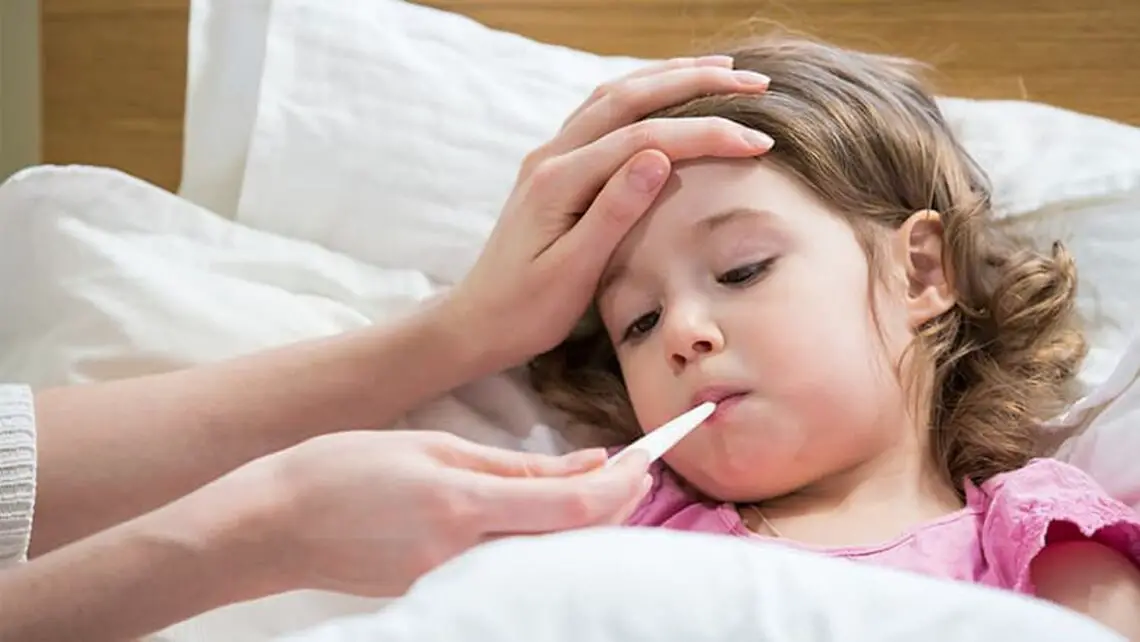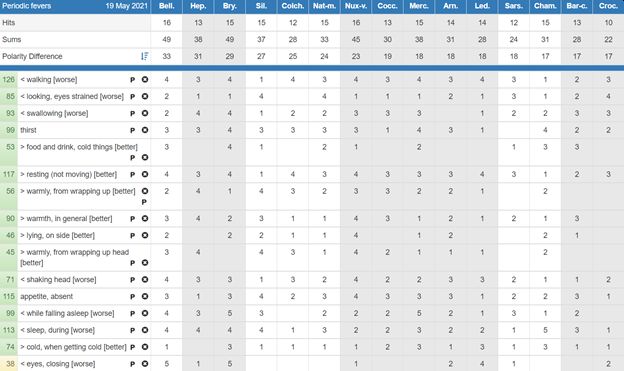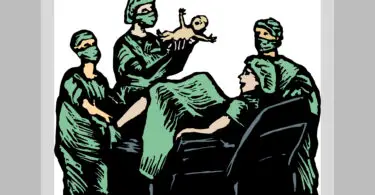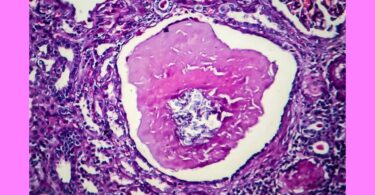Homeopathic repertories include rubrics for periodic and recurring fevers. However, until this client I had not had a client with such an illness. I received a call from a mom whose nearly 7-year-old daughter, whom I will call Jenny, had been suffering from monthly fevers for about 4 years.
According to conventional medicine, a fever is considered a body temperature of 100.40F or higher. A recurring fever is one of the main symptoms of a group of diseases called periodic fever syndrome. The term ‘periodic fever syndrome’ is defined as three or more episodes of unexplained fever in a six-month period, occurring at least seven days apart.
These episodes can occur at regular or irregular intervals. There are several types of periodic fever syndromes. These conditions are not caused by an infection like a typical fever. These syndromes mostly affect young children. It is common for these children to be generally healthy between fever episodes.
Jenny’s fevers began 4 years priorto our initial consultation when she was 3 years old. Due to a travel requirement to Mexico, she was given both the Tetanus and Hib vaccines. Within a day or two of vaccination, Jenny fell sick with a fever and soon tested positive for Strept throat.
She was given Amoxicillin. Since then, she experienced periodic fevers which evolved into a monthly cycle. On occasion, she would go longer than a month between episodes, but that was rare. She only tested positive for Strept throat once or twice following the initial episode.
I met with Jenny and her mom over Zoom and gathered the following information about her fevers. Every month, like clockwork, she would get a 1030 F fever that typically lasted for 3 days, sometimes 4. The fever was accompanied by burning in her throat, pain in her eyes, a headache and fatigue.
Her entire throat felt like intense burning, as if it had been burnt. Her throat was especially painful when swallowing. She found cold drinks to be soothing to her throat. She said the fever usually came on slowly. Sometimes “her tummy would hurt a little bit”.
Her head hurt “really badly”. She felt exhausted and usually spent 3 to 4 days lying on the couch. Her head hurt the most across her forehead. She found that applying ice to her forehead provided some relief. She described her eyes as feeling heavy.
Her mom indicated that Jenny wanted physical comfort when not feeling well. Her mom would often give her Tylenol to help with her fever and headache, which it did. Other than Tylenol, she was not taking any over-the-counter product or prescription medication. Between fever episodes, Jennyhad no other health complaints.
Jenny is a sweet and communicative girl. She is very physically active in outdoor activities and sports throughout the year. Despite her young age, she was able to work with me and provided very thoughtful answers. After reviewing the Polarity Analysis Checklist with Jenny and her mom, we identified the following indicators for her:
- Worse walking
- Worse straining eyes
- Worse swallowing
- Appetite absent
- Thirst (increased)
- Better cold food and drinks
- Worse warmth in general
- Better resting
I sorted my results by Polarity Difference (PD) and identified the top remedies. When Crocus came up with the highest PD, I went back to Jenny’s mom and asked if Jennyhad ever had any kind of bleeding issues, possibly nosebleeds. She responded that Jenny would often get a nosebleed at the end of the fever cycle, which her mom attributed to Tylenol.
I asked her to describe the blood and she told me it was dark and stringy, a striking confirmation of Crocus sativus. Given that Crocus had the highest PD and covered periodic fevers in addition to headaches located in the forehead, sore throat worse swallowing, fevers with nosebleeds and dark and stringy nosebleeds, it was an easy decision to start with this remedy. Jenny was given Crocus 6c in water, 4 drops, every other day.
Follow-up Visit #1
Jenny’s first follow-up occurred about six weeks later. She reported having a fever for 1 day this cycle, which never got higher than 1000 F. She felt fatigued and spent the day on the couch. She also had a headache, although it was not as painful and also only lasted for 1 day. She said her eyes felt “kind of heavy” and less painful than usual. She felt fine by her bedtime. She did not have a nosebleed. She also did not have a sore throat, which was very rare. She was not given any Tylenol. I did not change her dosing. She would remain on Crocus 6c, 4 drops, every other day.
Follow-up Visit #2
Jenny’s second follow-up occurred a little over a month after her previous visit. During this time, she went through another fever cycle where she had a similar experience to the one described in her prior visit. She had less than a full day of fever, again not exceeding 1000 F. By the end of that day, she felt completely back to her normal self. I increased Jenny to Crocus 12c and kept her to 4 drops, every other day.
Follow-up Visit #3
Jenny’s third follow-up occurred 1 month later. When she was due for her monthly fever cycle, it never came. Since having her periodic fevers, she did have a couple cycles without a fever, but it was extremely rare. Her mom reported that Jenny was “super happy, she loves school and she’s doing great”. I kept her on Crocus 12c, 4 drops, every other day.
Follow-up Visit #4
Jenny’s fourth follow-up occurred another month later. During her most recent cycle, she experienced the feeling “as if the fever was going to start” but it never did. Then about a week later, she experienced a painful headache. There was some concern that she had caught Covid, given this happened during the pandemic and this headache was off cycle and it was abnormal for her to have a headache outside of her fever episode. She was never tested for Covid. I had her stop Crocus 12c for a week. I then switched her to Crocus 30c, 4 drops, once weekly.
Follow-up Visit #5
Given that Jenny was doing really well and not really experiencing monthly fevers, I waited for about 10 weeks to assess her progress. She was continuing to have a single day per month where she felt fatigued, although was not developing a fever. Otherwise, she was doing really well. I stopped Crocus 30c and gave her a single, dry dose of Crocus 200c.
Follow-up Visit #6
I revisited Jenny 2 months following her single dose of Crocus 200c. Her mom indicated that she had a fever the day after taking Crocus 200c. It was very mild, not exceeding 990 F. Jenny felt “a little punky” for the day but returned to normal later that same day.
She then felt normal for several weeks until she had another fever episode, a few days before this follow-up. At that time, she had 2 days of a mild fever, never exceeding 1000 F. She also had a mild headache and some fatigue. She even had a little sore throat, which had not been bothering her for a few months.
Overall, her episodes had become much less intense and resolved more quickly than when she first started taking Crocus. However, I was hoping to see them resolve completely. I wanted to give this remedy one final chance. I gave Jenny a single, dry dose of Crocus 1M.
Follow-up Visit #7
Jenny returned for a follow-up 2 months later. Unfortunately, it seemed as though Crocus 1M had not helped. She had had 2 more monthly fever episodes, albeit mild. Her mom estimated that Crocus had overall helped Jenny by 90%. It was at this point I decided to redo Jenny’s Polarity Analysis. I went through the checklist with Jenny and these are the indicators that were now present:
- Worse walking
- Worse looking, eyes strained
- Worse swallowing
- Thirst (increased)
- Better cold food and drinks
- Better resting
- Better wrapping up warmly
- Better warmth in general
- Better lying on side
- Better wrapping up head warmly
- Worse shaking head
- Appetite absent
- Worse falling asleep
- Worse during sleep
- Better getting cold (cold application)
- Worse closing eyes
Note: It is common that the analysis changes over time. This seems to happen for 2 main reasons. First, after being on a healing remedy, the characteristics of the illness tend to change. Second, the client will provide more accurate reporting having gone through this process and now being more aware of their symptoms and associated modalities.
It is interesting that for Jenny, her new analysis brought up new remedies and Crocus became contraindicated based on her eyes feeling worse when closing. I chose to include that rubric, even though it was a smaller, yellow rubric (less reliable) and I had plenty of green rubrics (more reliable), as she felt it was an important, new symptom.
In reviewing the new analysis, it was nice to see Belladonna coming up with the highest PD. Another interesting point is that Belladonna did not come up high in Jenny’s first analysis. The PD for Belladonna was 6 points higher than the next remedy, Silica, and 8 points higher than the third remedy, Colchicum.
Of course, Belladonna is well known for fevers, sore throats and headaches. In Boenninghausen’s Repertory, it appears under Fever – pathological types – intermittent and periodicity – in general. Belladonna is also represented in periodic headaches and periodicity in general. It was an easy choice to select Belladonna as Jenny’s next remedy. I started her on Belladonna 12c, 4 drops, every other day. If an episode seemed to be starting, her mom was to give her up to 3 doses per day until it resolved.
Follow-up Visit #8
Jenny’s next follow-up occurred about 9 weeks after starting Belladonna. Her mom was unsure on the exact timing of her symptoms but she felt the fever cycle was more like 6 weeks after her previous episode (versus monthly). Jenny had recently had a day where she felt “like a fever was coming on”. As such, Jenny was given an extra dose of Belladonna 12c, which helped her to quickly feel normal.
Her mom estimated the change happened within 10 minutes. Jenny even had a burst of energy and wanted to go outside and play soccer with her friends. Other than that day, she had been feeling great. I now switched Jenny to Belladonna 30c, 4 drops, twice weekly.
About a month later, Jenny’s mom let me know that she started feeling a fever coming on within an hour of taking Belladonna 30c. I had her stop giving the remedy to Jenny entirely. She would now wait and only give a dose of Belladonna 30c if Jenny started feeling her fever cycle starting.
While this case is ongoing, Jenny’s recurrent fevers are nearly gone. Jenny’s mom recently shared that “Homeopathy has been an incredibly positive experience for my child. Her severe symptoms have decreased to the point of non-existence. I’m so grateful.”
In hindsight, I would have redone Jenny’s analysis and switched her from Crocus sooner. However, I am so grateful for Polarity Analysis, the repertory tool and the method, to quickly bring relief to Jenny. There are many benefits to this method but the most important is that it consistently brings better results sooner to my clients. I use PA nearly exclusively now for both chronic and acute illness.
For any professional homeopath interested in learning PA, I highly recommend attending the class offered through the Trinity Health Hub, taught by Tim Shannon, ND and Karen Allen, CCH. In addition to the training hours, this class includes many hours of “live” clinic cases as well as opportunities for case supervision.
References
American Family Physician (October 21, 2020). Recurrent Fevers in Children: Differential Diagnosis. https://www.aafp.org/afp/2003/0215/p863.html
Boger, C.M. (2010). Boenninghausen’s Characteristics & Repertory. New Delhi, India: B. Jain Publishers (P) Ltd.
Cleveland Clinic(October 20, 2020). Recurrent Fever.
https://my.clevelandclinic.org/health/symptoms/21185-recurring-fever
Medscape (July 19, 2019). Garg.Hereditary Periodic Fever Syndromes.https://emedicine.medscape.com/article/952254-overview






